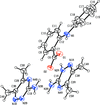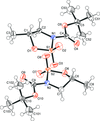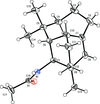issue contents
June 2017 issue

Cover illustration: Cyclic sulfamidates are valuable reactive intermediates, because ring-opening reactions proceed with total inversion at the stereogenic centre. The title compound represents such a building block derived from (R)-1-amino-2-propanol useful for the preparation of substituted ![[beta]](/logos/entities/beta_rmgif.gif) -phenylethylamines, an important class of pharmacologically active compounds. It crystallizes with two independent molecules in the asymmetric unit. In the crystal, C-H
-phenylethylamines, an important class of pharmacologically active compounds. It crystallizes with two independent molecules in the asymmetric unit. In the crystal, C-H O interactions are observed. The apolar tert-butyl groups and the polar sulfamidate rings are arranged alternately in layers parallel to the bc plane. See: Laus, Wurst, Nerdinger, Richter & Schottenberger [IUCrData (2017). 2, x170869].
O interactions are observed. The apolar tert-butyl groups and the polar sulfamidate rings are arranged alternately in layers parallel to the bc plane. See: Laus, Wurst, Nerdinger, Richter & Schottenberger [IUCrData (2017). 2, x170869].
metal-organic compounds


 access
access

 access
access

 access
accessorganic compounds


 access
access

 access
access

 access
access

 access
access

 access
access

 access
access

 access
access

 access
access

 access
access

 access
access

 access
access

 access
access

 access
access

 access
access

 access
access

 access
access

 access
access

 access
access

 access
access

 access
access

 access
access

 access
access

 access
access

 access
access

 access
access

 access
access

 journal menu
journal menu








































![[publCIF]](/logos/authorchecklist11.gif)





